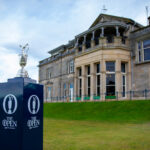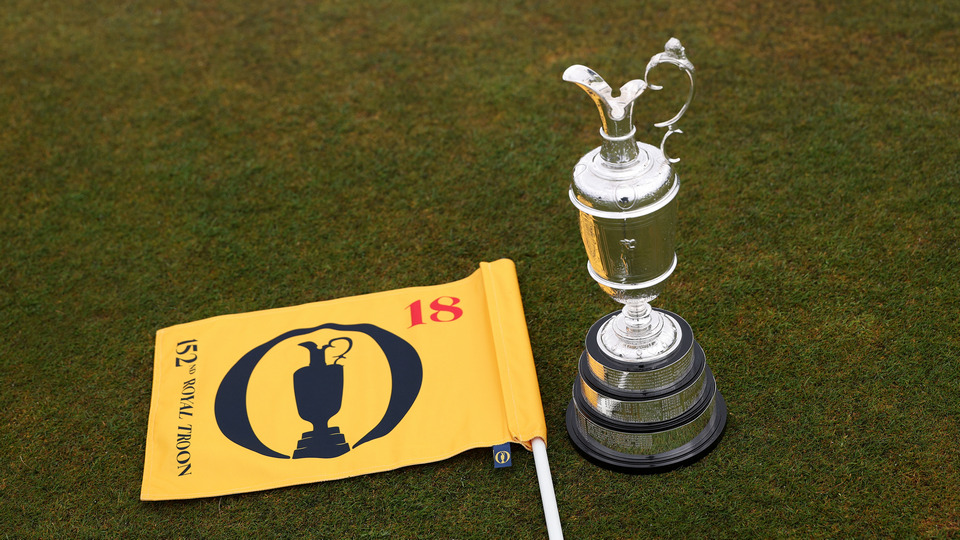TROON, SCOTLAND. The roots of the game are found at the core of The Open Championship. The playing of the event annually on a links course encapsulates the need for consummate shotmaking.
While the championship stretches back to 1860 it is especially noteworthy that after the end of World War II the modern golf era blossomed.
The Open progressed slowly from the tumultuous years of World War II but matters were helped when Sam Snead captured the Claret Jug at The Old Course at St Andrews in 1947.
The ten championships listed are noteworthy for the manner in which they brought to the forefront the man who ultimately prevailed and the way the game of golf was forever shaped because of the circumstances that took place.
***
1953 / Ben Hogan / Carnoustie
Hogan made only one visit to play in The Open Championship and his win only added to his considerable reputation. “Bantam” Ben successfully took home the Claret Jug with a 282 total (73-71-70-68) over the demanding Carnoustie golf links for a four-shot winning margin.
The win would be the 9th and final major championship title for his career – a total only exceeded by Walter Hagen, Bob Jones, Tiger Woods and Jack Nicklaus.
The host Scots were enthralled by his brilliant play and Hogan did not disappoint.
1962/ Arnold Palmer / Royal Troon
The intersection of Arnold Palmer and The Open turned around an event that was lacking steam and elevated it to global stature.
Palmer nearly won the 100th anniversary of the championship when played at St. Andrews in 1960. His return in 1961 earned him a victory at Royal Birkdale and that initial success was only the beginning.
In 1962 he returned to not only defend his title but set a new Open record with a four-round total of 276.
Palmer’s charisma and attacking golf style put into motion the rise of the championship as one of the key titles any elite golfer must possess.
1966 / Jack Nicklaus / Muirfield
The coming onto the pro golf scene of Jack Nicklaus in 1962 was much anticipated and the Golden Bear did not disappoint in winning the US Open that same year for his first pro golf title.
Nicklaus would add to his major total with wins at the Masters and PGA Championship in 1963. The missing title would be The Open Championship and Nicklaus was able to complete the career Grand Slam by winning in 1966 at Muirfield.
Jack’s win was a textbook demonstration in how to successfully maneuver around the demanding links. In all, Nicklaus would use his driver just 17 times during the event.
The victory so inspired Nicklaus that he named his home club just outside Columbus, OH – Muirfield Village.
1977 / Tom Watson & Jack Nicklaus / Turnberry
Rarely do the top two players in the world compete as fiercely as Tom Watson and Jack Nicklaus did for the 1977 Open Championship at Turnberry.
The epic meeting – tagged the “Duel in the Sun” pitted a determined Watson against the longstanding champion Nicklaus.
Watson only prevailed by a single shot with a tap-in birdie at the closing hole but only after Nicklaus made one final birdie from 45 feet. The four-round total of 268 by Watson and 269 by Nicklaus marked the first time 270 had been broken in a major event and was ten shots clear of third place finisher Hubert Green.
1984 / Seve Ballesteros / St. Andrews
The personal charm and swash buckling style of Seve Ballesteros evoked the style of Arnold Palmer albeit with a Spanish flair.
Ballesteros had come onto the world golf stage by finishing joint second at age 19 in the 1976 Open at Royal Birkdale.
Seve would go on to capture the Claret Jug three years later.
His most enduring triumph came five years later at The Old Course at St. Andrews.
Ballesteros would outplay Tom Watson down-the stretch who was seeking a three-peat defense.
The concluding birdie at the 18th gave rise to an emotional display of joy with Seve repeatedly fist bumping his jubilation. That specific episode is seared into Open Championship history.
2000 / Tiger Woods / St. Andrews
The arrival of Tiger Woods into professional golf in 1996 was highly anticipated. Woods did not wait long to make his mark winning the 1997 Masters in record fashion with a new four-round scoring mark of 270 and a 12-shot victory margin.
Woods would repeat what Nicklaus had done in 1966 by completing the career Grand Slam with a win at St. Andrews in 2000 and becoming the youngest golfer in doing so.
The victory was complete in all phases as Woods skillfully avoided hitting any of his shots into the fearer bunkers of The Old Course.
His winning margin of eight shots was another reminder that golf had a new king and the crown would remain in place for the foreseeable future.
2009 / Tom Watson / Turnberry
The play of 59-year-old Watson was beyond remarkable as the five-time winner of The Open nearly tied the mark of six wins by Harry Vardon.
Watson had won at Turnberry 32 years earlier in his epic meeting with Nicklaus and if not for an approach to the final green which failed to hold, he would have accomplished a feat beyond golf significance but in all of sports.
Watson would bogey the closing hole and eventually be beaten in an aggregate playoff with Stewart Cink. What Tom showed was how links golf can reward players who smartly play no matter one’s age.
2013 / Phil Mickelson / Muirfield
The win by Mickelson was completely unexpected as Lefty had little success in previous Open competitions with just two top ten finishes in twelve appearances.
After a crushing loss at the US Open at Merion just over a month prior, Mickelson put together his finest effort coming back from a five-shot deficit with a brilliant final round score of 66 in winning the Claret Jug.
Muirfield played firm and fast and the need for utmost precision and placement was a central demand for all who played.
Mickelson capped off the round by reaching the par-5 17th in two glorious shots and following that birdie sealed the triumph with a closing birdie at the final hole. Upon holing out Mickelson raised both arms in the air and the exaltation was quickly acknowledged by the Scottish gallery.
2016 / Henrik Stenson and Phil Mickelson / Royal Troon
Just as Tom Watson and Jack Nicklaus separated themselves from the rest of the field, the contest between Stenson and Mickelson was miles beyond all others.
The talented Swede earned his first major win with a record 264 total and a final round 63 to best the American left-hander by three shots.
The score marked the lowest 72-hole score for the championship and Mickelson’s 267 total was the lowest score for a runner-up and he outpaced the third place finisher J.B. Holmes by eleven shots.
The quality of the play between the two during the final 18 holes was beyond what all others had done previously.
2019 / Shane Lowry / Royal Portrush
A Hollywood ending came onto being with a script no one could envision. For the first time in the championship’s history the Open was played outside of Scotland and England.
Northern Ireland was the host and Royal Portrush’s Dunluce Course the venue for the world’s best players.
Ireland’s Shane Lowry galvanized the home audience with a six-shot win and the resulting joy resonated throughout the Irish isle.
The Open returns to Portrush in 2025 but the fireworks provided from the first-time hosting will be incredingly hard to top.

Related: The Lore of the Links
For the latest news in the golfing world, follow us on X (Formally Twitter).

